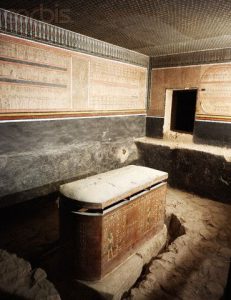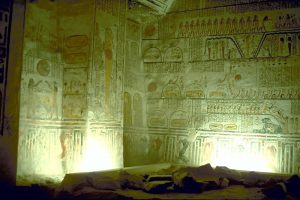
Amenhotep II, son of Tuthmosis III, is widely considered, from both military and administrative perspective, as one of the great Ancient Egyptian rulers. He led a number of successful military campaigns especially to Nubia and Asia, during the early years of his time in power. Amenhotep II ruled the country for about 34 years. He renovated and enlarged the two temples in Amada and Elephantine that originally constructed by his father. His tomb, known as the royal cachette, is considered one of the most remarkable and impressive tombs in the Valley of the Kings. It lies about 150 meters west to the famous tomb of Tutankhamen.
This tomb has a lot in common with that of Tuthmosis III (KV 34); the main difference is the more complex structure of the burial chamber. It is designed in a rectangular shape, with six pillars supporting its ceiling. It is divided into two parts on different levels. The entrance of the tomb was roofed over to prevent future flood damage like that which occurred in 1994 when rain entered the tomb. Before the roof was built, the tomb entrance was very well closed. That's why it was chosen by priests in the tenth century to be as a place to hide the royal mummies from thieves (royal cachette).
- Structure of the Tomb of Amenhotop II
The basic plan of the Tomb of Amenhotep II is similar to that of Thutmosis III, but with little differences. A steep set of entry stairs leads to a sloping corridor, then to a second set of stairs, a second corridor, and a well chamber. Here, the well shaft is about 6.5 meters deep and has a small, rectangular chamber cut at the bottom. Scholars suggest that the well was more likely a symbolic tomb for the god Osiris than a device to trap rainwater or thwart thieves. There are two-columned chamber lies beyond. As in KV 34, a steep stairway was cut through its floor in the left front corner. These steps lead to a third sloping corridor, and beyond it, we can find the burial chamber.
- The Burial Chamber of the Tomb of Amenhotep II

The only decorated part of Burial Chamber of the Tomb of Amenhotep II is painted in red and black ink with scenes from the Book of Amiduat, while the ceiling is decorated with yellow stars on blue background figuring the night and the sky. On the left wall, in the upper level of the chamber, the visitor can see a very impressive scene from the tenth hour of the Imydwat representing Nun, the primeval ocean and twelve men who have died by drowning in the Nile. On the front wall, in the upper register, the seventh hour of the Imydwat represents Osiris sitting on his throne protected by a huge snake. A god with the ears of a cat beheads the enemies of Osiris. Below, Isis stands in the prow of a boat as the evil Apophis-serpent is rendered harmless by knives and ropes. On the pillars: one can admire the full-length portrait of the king before Hathor, Osiris and Anubis.
The brush strokes used for these schematic stick figures and cursive hieroglyphs were made with a high confidence. The faces of the six pillars show the king in front of several deities, each deity offers him an ankh-sign (the ankh sign represents life).The scene is surrounded by a band of yellow, red, and blue rectangles. Three deities are represented on faces of the six pillars .Hathor (she is the only goddess depicted), Osiris, and Anubis. They are those who will protect the king in the next life. The hieroglyphic inscriptions give the name of the king and of the god with whom he stands, and sometimes the phrase, "The Beloved of Osiris". The visitor clearly can notice how the artist was very skillful in depicting the scenes of the pillars.
- The Sarcophagus of King Amenhotep II (1424-1397 BC)
King Amenhotep II's yellow quartzite sarcophagus lies in the lower level of his tomb at the Valley of the Kings. Like the sarcophagus of Thutmes III, it was painted to simulate granite. Four small rectangular holes are cut in the lower section of the burial chamber, two in the rear wall, one each in the rear face of the last pair of pillars. Thus, they surround the sarcophagus. These are called magical brick niches and were intended to house small mud bricks on which part of spell 151 from the Book of the Dead was incised or painted and which were accompanied by the figure of a mummy or a jackal or the hieroglyph meaning "to endure". A part of the text reads, "1 have come as your protection, and my protection will be about you forever." In the lower level, there was the quartzite sarcophagus. It was found by Victor Loret in a very well preserved state. Despite the fact that the tomb had been stolen, the royal mummy was still inside, wearing its wreath of flowers. It was taken to the Egyptian Museum in 1928.
- The Cachette of the Tomb of Amenhotep II
In the year 1898, along the side walls of the Burial Chamber of Amenhotep II, in the two side chambers on the west side (to the right facing the sarcophagus), Loret found 9 royal mummies. These mummies (now displayed at the Egyptian museum in Cairo) belong to Amenhotep III, Thutmosis IV, Sety II, Merenptah, Siptah, Setnakht, Ramses IV, Ramses V, and Ramses VI. Since this tomb was considered more secure, the mummies had been taken from their original tombs and transported here. This occurred in the Twenty-First Dynasty during the reign of King Pinedjem I.
